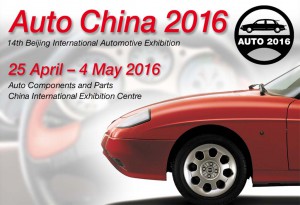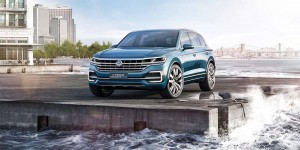Dozens of cars, trucks, concepts and crossovers are making their debut at the Beijing Auto Show today, everything from locally made battery-electric vehicles to Ford’s big F-150 Raptor pickup.
But the tone at the event is decidedly lower key than in the past, and for obvious reasons. This year marks the first time since the Chinese automotive market shifted into high gear at the beginning of the Millennium that sales are expected to grow at a single-digit pace.
And, after years of struggling to keep up with booming demand, even as they spent tens of billions of dollars opening up new plants, automakers now face the very real possibility that China could soon face a very different situation, something more common in Europe and North America: over-capacity.
Compounding matters, the Beijing government is doing little to disguise its strategy of helping China’s increasingly aggressive domestic manufacturers finally take on the foreign-owned brands that have long dominated the market.
There is little chance that China will lose its position as the world’s largest automotive market, but the days of annual sales growth running as high as 50% or more seems to be over. Even maintaining a low double-digit pace seems unlikely for now. The China Association of Automobile Manufacturers has set a target of around 7% year-over-year growth, but even that number is starting to look optimistic.
“The market is slowing down,” cautioned Michael Dunne, of Dunne Automotive, a long-time analyst specializing in the Asian region.
And, were it not for surging demand for SUVs, as well as strong government support for battery-electric vehicles, 2016 could see sales flat-line all together. Demand for SUVs was up 52% in 2015, while sedan sales dipped 5.3%% and minivan sales were off 17.5%.
(For more on the boom in Chinese SUV sales, Click Here.)
The shift to SUVs, “In our opinion, is a trend which is going to continue,” suggested Renault-Nissan Alliance CEO Carlos Ghosn.
Exactly how much the overall Chinese market is weakening depends upon whom you ask. BMW is on the bearish side. It reported growth of just over 1% in 2015 and expects to deliver only slightly better numbers this year. Toyota predicts its numbers – sales last year came to 1.15 million – will be flat in 2016.
Some manufacturers, however, remain decidedly upbeat. That’s particularly true of brands that were slow to enter the market. That includes Jeep, which is highlighting the Renegade and other SUVs at the Beijing show. It has opened two new plants in China since last autumn and is confident it is positioned to take advantage of the shift from cars to utility vehicles.
(For more on Jeep’s China plans, Click Here.)
Cadillac and Lincoln are also relative latecomers hoping to pick up momentum by targeting China’s still relatively healthy luxury car market. Cadillac, which has opened its own production base to help it sidestep hefty import tariffs, expects to top 100,000 sales in China this year, which would mean a 25% growth rate. For now, Lincoln remains reliant on imports, but with dozens of new dealerships opening across the country this year, it is also forecasting double-digit growth.
Its parent, Ford Motor Co. , however, appears far less upbeat. Ford was slow to target China, at least compared to key rivals General Motors and Volkswagen. But it has been making up for lost time by adding an assortment of new models and investing billions in the plants needed to build them. This year, however, CEO Mark Fields said he has “nothing that we’re ready to talk about” in terms of future investments in new capacity.
Ford expects the Chinese market to grow only 3.7% in 2016, to no more than 25.5 million. And GM anticipates the overall Chinese market won’t do much better than low single-digit growth through the end of the decade. The question is whether that will be enough to sustain the plants already in operation and all the new facilities that plan to open over the next several years.
That’s particularly worrisome for foreign manufacturers that depend heavily on China. A total of 37% of GM sales come from the once-booming market – more than from all of North America. Volkswagen isn’t far behind, at 36%.
While Toyota is less dependent on China – which accounts for about 11% of its global sales – the Japanese giant has other reasons to worry. It had been hoping to build share by adding new gas-electric models, such as the RAV4 Hybrid making its debut at the Beijing Auto Show this week. But despite putting a premium on cleaner, battery-based vehicles, the government won’t authorize incentives for those vehicles.
Instead, domestic makers like BYD that produce all-electric or plug-in models, seem the primary, targeted beneficiaries of incentives that run as much as 114,000 yuan, or $17,500, per vehicle. Their products also sidestep the registration limits placed on conventional, gas-powered models in Beijing, Shanghai and a number of China’s other large cities.
(Chinese start-up LeEco could tackle Tesla with the production version of the LeSEE concept. Click Here for more.)
As if the slowdown in sales isn’t enough to worry about, automakers are facing increased pressure to trim prices as competition grows. And that, in turn, is hurting profits. Pre-tax profits among top manufacturers in China fell 1.1% last year, according to research by Sanford C. Bernstein.
Despite such headaches, the situation is far from dire. And, as this year’s Beijing show demonstrates, automakers are still pushing out more new products than ever before. It’s still the world’s largest automotive market – and much of the country has yet to experience the massive growth seen in Pacific coast cities like Beijing and Shanghai.
But the days when automakers could sell everything they rolled out seems to be coming to an end. Competing in China is becoming as difficult as it is everywhere else in the world.





